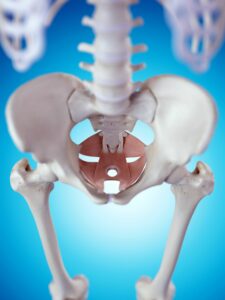When we discuss men’s health, the conversation often revolves around topics such as prostate health, preventing prostate cancer, and maintaining cardiovascular well-being.
However, there exists a lesser-known aspect of men’s health that frequently goes unnoticed or untreated – male pelvic floor dysfunction. This condition can contribute significantly to a range of symptoms, yet it often eludes diagnosis and appropriate management.
Male Pelvic Floor Dysfunction
At Rebalance, we frequently field inquiries related to women’s health and pelvic floor dysfunction. However, it’s crucial to recognize that men can also experience pelvic pain and discomfort. These issues may manifest as hip pain, abdominal discomfort, pelvic pain, lower back pain, or even symptoms resembling prostatitis.

Consider these startling statistics:
- Approximately 10 percent of men will encounter pelvic pain symptoms during their lifetime.
- Roughly 50 percent of men will grapple with prostate-related concerns at some point.
- Astonishingly, 97 percent of men who exhibit symptoms of prostatitis are prescribed antibiotics, despite lacking evidence of prostate or bladder infection.
- Many of these individuals, who show no signs of infection, may actually be suffering from pelvic floor dysfunction, a condition that can be effectively addressed through physical therapy.
Prostatitis and Its Link to Male Pelvic Floor Dysfunction
One form of prostatitis associated with male pelvic muscle dysfunction is known as chronic pelvic pain syndrome. It isn’t a disease per se, but rather a condition that can present in various ways with overlapping causes. In addition to pelvic pain and symptoms akin to prostatitis, it can lead to the following issues:
- Difficulty initiating urination, starting the urinary stream, or straining while urinating.
- Urinary urgency and increased frequency of urination.
- A sensation of burning during or after urination.
- Alterations in erectile function, ejaculate quality, and orgasm intensity.
- Pain experienced during ejaculation.
- Discomfort or difficulty during bowel movements.
- Pain in the perineum, penis, or anus.
- Perineal, penile, or anal discomfort that intensifies when sitting or engaging in physical activity.
- Lingering pain in the abdomen, groin, legs, or back following exercise or heavy lifting may also signal an underlying pelvic floor issue.
If you have encountered any of the aforementioned symptoms or suspect that you may be grappling with pelvic floor problems, we encourage you to reach out to us. You can schedule an initial evaluation with our team, or if you are outside the Greater Philadelphia region, we can explore alternative treatment options to address your specific needs. Don’t let male pelvic floor dysfunction go undiagnosed or untreated; there are effective solutions available to help you regain your comfort and quality of life.
















